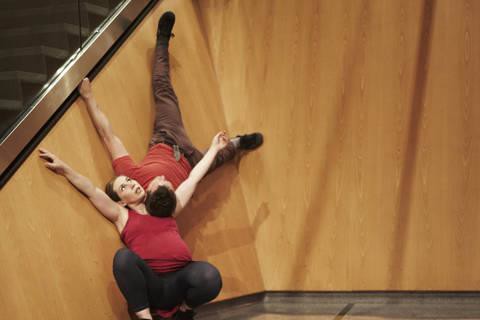Review in Dance Current:
http://www.thedancecurrent.com/review/night-museum
DIVERGENT DANCES FOR WINDOWS AND WALLS
Anandam Dance
Toronto July 24 – 28, 2012
Anandam Dancetheatre’s latest work, Divergent Dances for Windows and Walls, is the second of three installments in a multi-year choreographic project with the Bata Shoe Museum. Under the artistic direction of Toronto’s Brandy Leary, the performance installation is a melding of spectacle and public participatory art using urban architecture.
On opening night, after much shuffling and sidestepping by the audience to fit in and get out of the way in the museum’s main entrance space, collaborator and performer Kevin O’Connor arrives to welcome us all and explain a bit about the work. Among other things, he mentions that the company had asked in the process of creation whether one body could slow down an entire street. In this case, Bloor Street, one of Toronto’s busiest, where the museum is located.
The performers are dressed in their own comfortable clothing and are only identifiable because they are wearing sensible shoes in the hot heat of summer. Sneakers enabled the aerial artists to hoist themselves up the ropes and for all the performers to be fully physical within the performance space, both inside and out. No explicit distinction was made between the rope-based aerialists and the dancers; however, the aerial artists could more easily perform both roles. (I imagine aerial work is not an easy thing to pick up just for a gig.)
Starting outside the museum, Leary, Mark Segal, Natasha Danchenko and O’Connor begin to climb, spin and flip their way up and down suspended lines of rope that hang from the museum’s roof. I am most drawn to Danchenko who draws out a series of attitude jumps as she hangs on her side, making her way slowly to the ground. Inside, when she’s more fully in the performance setting, she seems to disappear.
Once this section of aerial work resolves, another group of performers appear in the ground-level windows of the museum, planting every part of their body against the windows and slowly sliding towards the entrance as the audience makes its way back inside.
Scattered throughout the staircases connecting the basement to the third floor, the performers keep busy descending or ascending within the space. They create human steppingstones with one another on the stairs, maneuvering down one of three ropes that hang from the museum’s ceiling (oddly, the Bata Shoe Museum already had the fixtures on which to hang these giant ropes) or visiting the outside spaces. All the while the audience moves around freely, watching the show from whatever vantage point suits them best. The environment is casual and easy; watching is peaceful and lightly entertaining.
At one point I find myself standing near the window and notice the sound of water coming from the sound system. I stood there listening, watching the street, until I realized I was hearing a live recording of outside on this suddenly wet Toronto night. The live stream was being played simultaneously as part of composer James Bunton’s ambient sound score. Before the show, we’d all been encouraged to add Bunton’s minimal tracks to our music devices for when we stepped outside the museum’s doors to observe anything happening outside. The recording was subtle but added just enough urban influence to create a relationship between the outside world and the inside.
Choreographically, the work is a combination of tasks and improvisations. The performers either engage with the audience – the very pregnant Amy Hampton had me carry a rope downstairs – or, off in their own world, create beautiful moments of juxtaposition with the architecture and with each other. It becomes an active choice to stay out of the work – moving as the dancers roll down the stairs at you – but when asked, many do as they’re told, carrying Jennifer Robichaud out of the building, or improvising with Segal on the ropes. These interactions were, I imagine, different every night.
The final moment is as casual and tranquil as most of the rest of the work: volunteer audience members entangle themselves in the ropes, leaning out together, creating a structure of tension for the performers to move in, hang on and maneuver around. After a few moments of this, the rope holders collectively come back on to their feet, everyone applauds and the work is done.



